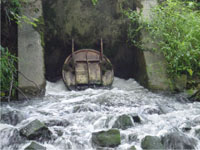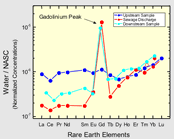Tracing Wastewater - Using Unique Compounds to Identify Sources of Contamination
 Discharge from a wastewater treatment plant on Fourmile Creek, Iowa. USGS scientists have been studying the fate and transport of emerging contaminants in the creek and their potential use as indicators of wastewater contamination
Discharge from a wastewater treatment plant on Fourmile Creek, Iowa. USGS scientists have been studying the fate and transport of emerging contaminants in the creek and their potential use as indicators of wastewater contamination
(Click on photo for larger version) |
|
U.S. Geological Survey (USGS) and U.S. Environmental Protection Agency (EPA) scientists have shown that wastewater treatment plants are a significant source of pharmaceuticals and other emerging contaminants to rivers. A recent study analyzed treated wastewater being discharged to rivers from 10 wastewater treatment plants (sewage treatment plants) for 110 emerging contaminants, and found between 28 and 50 of these compounds in the wastewater. Commonly detected compounds included antimicrobial disinfectants (triclosan), antibiotics (sulfamethoxazole), musk fragrances (tonalide), antihistamines (diphenhydramine), and antiepileptic drugs (carbamazepine). After analyzing water-quality samples that were collected upstream and downstream of the treatment plants, the scientists determined that wastewater treatment plants are a significant source of emerging contaminants in the streams that were sampled.
This study and others provide evidence that many emerging contaminant compounds may make ideal tracers and indicators of wastewater in rivers and other water bodies because they are used only by humans. For example:
-
 Average frequency of detection of emerging contaminants by compound class in 10 wastewater discharges from across the Nation. Numbers in parentheses indicate the number of compounds in each class
Average frequency of detection of emerging contaminants by compound class in 10 wastewater discharges from across the Nation. Numbers in parentheses indicate the number of compounds in each class
(Click on photo for larger version) |
|
 Concentrations of rare earth elements in wastewater discharged to Boulder Creek, Colorado, compared with upstream and downstream samples. Concentrations are normalized to the North American Shale Composite**, and shown on a logarithmic scale. Upstream sample is 60 meters upstream and the downstream sample is 0.5 kilometers downstream of the wastewater discharge point
Concentrations of rare earth elements in wastewater discharged to Boulder Creek, Colorado, compared with upstream and downstream samples. Concentrations are normalized to the North American Shale Composite**, and shown on a logarithmic scale. Upstream sample is 60 meters upstream and the downstream sample is 0.5 kilometers downstream of the wastewater discharge point
(Click on photo for larger version) |
|
USGS and EPA scientists have identified 35 compounds in wastewater from sewage treatment plants that have the potential for use as indicators of human fecal contamination. Water resource managers need rapid methods
to assess whether or not drinking and recreational waters are free from pathogens associated with human fecal matter in many wastewaters. Current methods are very time consuming, and these compounds could potentially be used as an early warning of the likelihood for unhealthy conditions. Many pharmaceuticals, such as carbamazepine and diphenhydramine, are candidates because they are ingested and excreted by humans.
-
In another study, USGS scientists have shown that the discharge from wastewater treatment plants can be enriched with gadolinium (Gd), a rare earth element.
Gadolinium is used by medical facilities as a contrasting agent for MRIs (magnetic resonance imaging). Organometalic gadolinium complexes make good contrasting agents because of their large magnetic moments and extreme stability in the human body. Their stability and their ease of measurement (when compared to many emerging contaminants that are organic compounds) make them ideal tracers of wastewaters in the environment. Water resource managers could use gadolinium in studies of the effects of wastewaters on streams, wetlands, and other water bodies.
References
- Glassmeyer, S.T., Furlong, E.T., Kolpin, D.W., Cahill, J.D., Zaugg, S.D., Werner, S.L., Meyer, M.T., and Kryak, D.D., 2005, Transport of chemical and microbial compounds from known wastewater discharges – Potential for use as indicators of human fecal contamination: Environmental Science and Technology, v. 39, no. 14, p. 5157-5169, doi: 10.1021/es048120k.
- Verplanck, P.L., Taylor, H.E., Nordstrom, D.K., Barber, L.B., 2005, Aqueous stability of gadolinium in surface waters receiving sewage treatment plant effluent, Boulder Creek, Colorado: Environmental Science and Technology, v. 39, no. 18, p. 6923-6929, doi: 10.1021/es048456u.
Names and Symbols of the Rare Earth Elements
La |
lanthanum |
Tb |
terbium |
Ce |
cerium |
Dy |
dysprosium |
Pr |
praseodymium |
Ho |
holmium |
Nd |
neodymium |
Er |
erbium |
Pm |
promethium |
Tm |
thulium |
Sm |
samarium |
Yb |
ytterbium |
Eu |
europium |
Lu |
lutetium |
Gd |
gadolinium |
Y |
yttrium |
|
More Information
Related Headlines
** North American Shale Composite (NASC) – The North American Shale Composite is a standard reference sample composed of 40 different shales, some of which are from Africa and Antarctica. Scientists use the NASC to compare results of elemental analysis of rocks and water samples against the know analysis of the standard.
Gromet, L.P., Dymek, R.F., Haskin, L.A., and Korotev, R.L., 1984, The "North American Shale Composite:" its compilation, major and trace element characteristics. Geochimca et Cosmochimica Acta, v. 48, p. 2469-2482. |
USGS Information on Gadolinium
Back to Headlines page
|

|